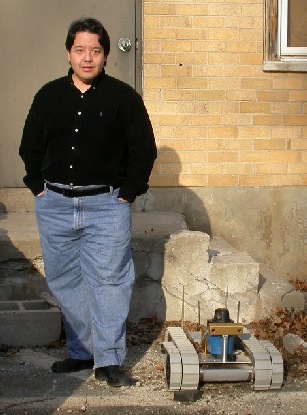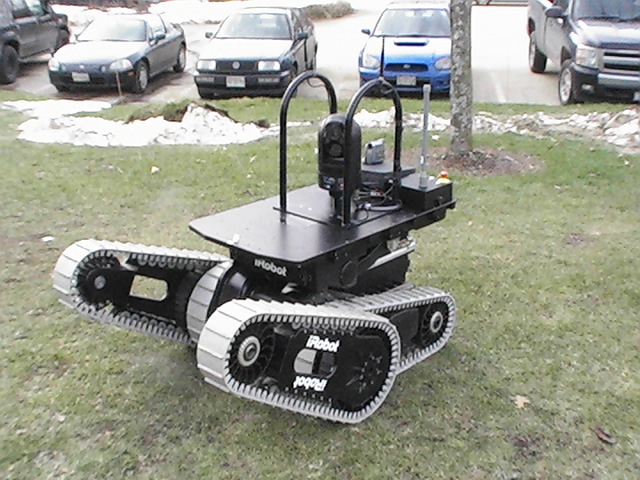|
Brian Yamauchi † Head of Software
Engineering 13030 Cerise Ave Hawthorne, CA 90250 |
|
Starpath
|
|
Iím part of
the leadership team at Starpath, where
weíre building autonomous Rovers to mine the Moon for rocket fuel.† Our plan is
to launch a fleet of Rovers to the Lunar South Pole, where they will mine icy
regolith from the permanently shadowed regions (PSR) of craters and deliver that
regolith to a processing Plant.† The
Plant will extract water from the regolith and convert it into liquid oxygen
that can be used to refuel landers such as SpaceXís Starship and Blue Originís
Blue Moon.† Refueling on the lunar surface will reduce
the cost of launching payload to the Moon and accelerate the construction of
a permanent lunar base. As Head of
Software Engineering, Iím leading the team that will develop all of the
software for our Starmine system.† This
includes the autonomy and control software that will enable our Rovers to
navigate autonomously into PSRs, as well as the software for communications
and teleoperation, and for control of the Plant and the solar power Tower
that will provide energy for the entire system. Our Rover 9
prototype won first place (2023) and second place (2024) in NASAís Break the Ice Challenge
for lunar mining rovers.† Our Rover 10
prototype recently passed thermal and vacuum (TVAC) testing at NASA Marshall
Spaceflight Center, demonstrating the ability to operate in the thermal
and vacuum conditions of the Lunar South Pole.† I presented a talk on Starmine at the 2nd Space
Robotics Workshop at IEEE
SMC-IT/SCC 2025 in Los Angeles, and a video and slides are
available. |
Boston Dynamics
I
was previously a Principal Roboticist at Boston Dynamics, working to increase
the autonomous capabilities of our quadruped robot, Spot.† I developed software to enable Spot to
navigate more intelligently and robustly in dynamic environments and industrial
facilities.

Argo AI
I
worked on self-driving cars for Argo AI in Palo
Alto, as a Senior Staff Software Engineer on the Autonomy Integration Team.

(Image
source: Argo AI)
Anki
I
was a Technical Director for robot navigation at Anki.† I provided technical direction in navigation
for Anki's planned line of future home robot products, and I designed and
implemented the navigation system for a prototype home robot.† This system combined open-source and custom
software for frontier-based exploration, SLAM, path planning, and obstacle
avoidance in dynamic environments.
iRobot Terra Robot Mower
|
|
I worked at iRobot for
19 years on a wide range of robotics programs ranging from advanced military
research to mass-market consumer robots.†
Most recently, I spent several years as a Principal
Robotics Engineer working on iRobot's Terra
robot lawnmower. I developed the initial proof-of-concept prototype for
the wireless robot confinement system, and also worked on the navigation,
path following, obstacle avoidance, and lawn training software. |
Robots Podcast Interview
I was
interviewed for the July 2nd, 2010 episode of the Robots Podcast,
where I discussed robotics research at iRobot and the future of robotics.† You can listen to this interview on the Robots
Podcast website or download the episode via iTunes.
The
Dynamo Project
|
|
I was the
Principal Investigator (PI) for the Dynamo Project, a project funded by the DARPA Defense Sciences Office to develop
fast learning techniques for mobile robots driving at high speeds and over
rough terrain.† Dynamo is part of the
DARPA Maximum Mobility and Manipulation (M3) Program.† For Dynamo, we developed a new algorithm,
Dynamic Threshold Learning (DTL), for rapid learning of robot control
behaviors. |
The Stingray Project
|
|
I was the PI for Stingray, a Phase II SBIR project
funded by the US Army Tank-Automotive
Research, Development, and Engineering Center (TARDEC). The goal of
this research project was to develop techniques for high-speed teleoperation
of small unmanned ground vehicles (UGVs).†
We worked with Chatten
Associates to integrate their Head-Aimed Remote Viewer (HARV) with iRobot
unmanned ground vehicle (UGV) platforms. The HARV combines a
head-tracking system with a head-mounted display and a remote gimbaled
camera. The camera tracks every motion of the operator's head,
providing the illusion of being in the vehicle, and greatly increasing
situational awareness.† We also developed
semi-autonomous behaviors to help the operator control these UGVs at high
speeds. This video shows our initial experiments using the HARV to drive the prototype Warrior and a high-speed surrogate UGV (a modified, gas-powered R/C car used for testing) through a slalom course. |
The
Daredevil Project
|
|
|
I was the
PI for the Daredevil Project, a Phase II SBIR project funded by TARDEC.† For Daredevil, we developed the perception
techniques to allow robots to see through adverse weather (fog, rain, snow)
and sparse foliage.† Robots often use
LIDAR (laser ranging) or vision to detect obstacles, but these sensors have
difficulty seeing through adverse weather and can be completely blocked by
fog, smoke, or dust.† For Daredevil we
used ultra wideband (UWB) radar in combination with LIDAR and vision to allow
the Daredevil PackBot to avoid obstacles in all-weather conditions. These
images show how UWB radar can see through dense fog that blinds LIDAR and
vision.† On the left, the Daredevil
PackBot is in clear air, and both radar (green points) and LIDAR (red points)
can see the obstacles in the room.† In
these conditions, LIDAR provides more precise range data with better angular
resolution.† On the right, the
Daredevil PackBot is immersed in dense fog in the same room.† The LIDAR is unable to penetrate the fog
beyond a depth of about one meter, but the UWB radar is completely
unaffected.† If the robot were only
equipped with LIDAR and vision, it would not be able to move safely in a
fog-filled environment, but using UWB radar, the Daredevil PackBot is able to
successfully avoid obstacles even in dense fog. For more
details, see my papers for ICRA 2010
and SPIE
Unmanned Systems 2010. |
|
|
|
The Wayfarer Project
|
I was also the PI for the TARDEC-funded Wayfarer Project, a two-year, $1.3 million effort to develop autonomous urban navigation capabilities for man-portable mobile robots, such as the iRobot PackBot. We equipped two Wayfarer PackBot prototypes with stereo vision and LIDAR to perform autonomous reconnaissance missions in urban terrain, including GPS-denied areas. The new ruggedized Wayfarer navigation payload is shown at left, and a 3D map generated by the Instant Scene Modeler (iSM) during perimeter reconnaissance is shown at right. (iSM was developed by Stephen Se at MDA Corporation and was integrated with Wayfarer at iRobot Corporation.) |
Wayfarer Videos
- Rugged
Navigation Payload (3 MB) (high-quality
20 MB)
- Perimeter Reconnaissance with iSM 3D Mapping
- Route
Reconnaissance (7 MB) (high-quality
25 MB)
- Perimeter
Reconnaissance (16 MB) (high-quality
31MB) including:
- Perimeter Following
- Mapping
- Obstacle Avoidance
- Automatic Flipper Deployment
- Indoor Mapping
(6 MB) (high-quality11MB)
- Outdoor
Obstacle Avoidance (10 MB) (high-quality
20MB)
Previous Research
View the robots I've developed in my Robot Gallery.
I've previously conducted research and development in mobile robotics at:
- Naval
Research Laboratory
- Institute for the
Study of Learning and Expertise
- Case
Western Reserve University
- NASA Kennedy
Space Center
- Jet Propulsion
Laboratory
- Hughes Research
Laboratories
While at the Naval Research Laboratory, I developed frontier-based exploration, a technique that allows mobile robots to explore and map unknown environments.
Selected
Publications
All-Weather
Perception for Man-Portable Robots Using Ultra-Wideband Radar
Brian Yamauchi, Proceedings of the 2010 IEEE International Conference on
Robotics and Automation (ICRA 2010),
Anchorage, AK, May 2010
Fusing
Ultra-Wideband Radar and LIDAR for Small UGV Navigation in All-Weather
Conditions
Brian Yamauchi, Proceedings of SPIE Vol. 7692 (DS117): Unmanned Systems
Technology XII, Orlando, FL, April 2010
Autonomous Urban Reconnaissance
Using Man-Portable UGVs
Brian Yamauchi, Proceedings of SPIE Vol. 6230: Unmanned Systems Technology
VIII, Orlando, FL, April 2006
Wayfarer: An Autonomous
Navigation Payload for the PackBot
Brian Yamauchi, Proceedings
of AUVSI Unmanned Vehicles North America 2005, Baltimore, MD, June 2005
The Wayfarer Modular Navigation
Payload for Intelligent Robot Infrastructure
Brian Yamauchi, Proceedings of SPIE Vol. 5804: Unmanned Ground Vehicle
Technology VII, Orlando, FL, March 2005
Griffon: A
Man-Portable Hybrid UGV/UAV
Brian Yamauchi and Pavlo Rudakevych, Industrial Robot, Vol. 31, No. 5,
pp. 443-450, 2004
PackBot: A Versatile Platform for Military Robotics
Brian Yamauchi, Proceedings of SPIE Vol. 5422: Unmanned Ground Vehicle
Technology VI, Orlando, FL, April 2004
Integrating Exploration and
Localization for Mobile Robots
Brian Yamauchi, Alan Schultz, and William Adams, Adaptive Behavior, Vol.
7, No. 2, Spring 2000
Mobile Robot Exploration and
Map-Building with Continuous Localization
Brian Yamauchi, Alan Schultz, and William Adams, Proceedings of the 1998
IEEE International Conference on Robotics and Automation, Leuven, Belgium,
May 1998, pp. 3715-3720
Frontier-Based Exploration
Using Multiple Robots
Brian Yamauchi, Proceedings of the Second International Conference on
Autonomous Agents (Agents '98), Minneapolis, MN, May 1998, pp. 47-53
A Frontier-Based Approach
for Autonomous Exploration
Brian Yamauchi, Proceedings of the 1997 IEEE International Symposium on
Computational Intelligence in Robotics and Automation, Monterey, CA, July
1997, pp. 146-151
Place Recognition in Dynamic
Environments
Brian Yamauchi and Pat Langley, Journal of Robotic Systems, Special
Issue on Mobile Robots, Vol. 14, No. 2, February 1997, pp. 107-120
Spatial Learning for Navigation
in Dynamic Environments
Brian Yamauchi and Randall Beer, IEEE Transactions on Systems, Man, and
Cybernetics - Part B: Cybernetics, Special Issue on Learning Autonomous
Robots, Vol. 26, No. 3, June 1996, pp. 496-505
iRobot marks and media are used with permission. All rights reserved. Most content and media hosted on robotfrontier.com is available for public, private, and media use, on the condition that the content or media is used with appropriate attribution. Please contact me for permission to use any content or media from robotfrontier.com in your own work.










